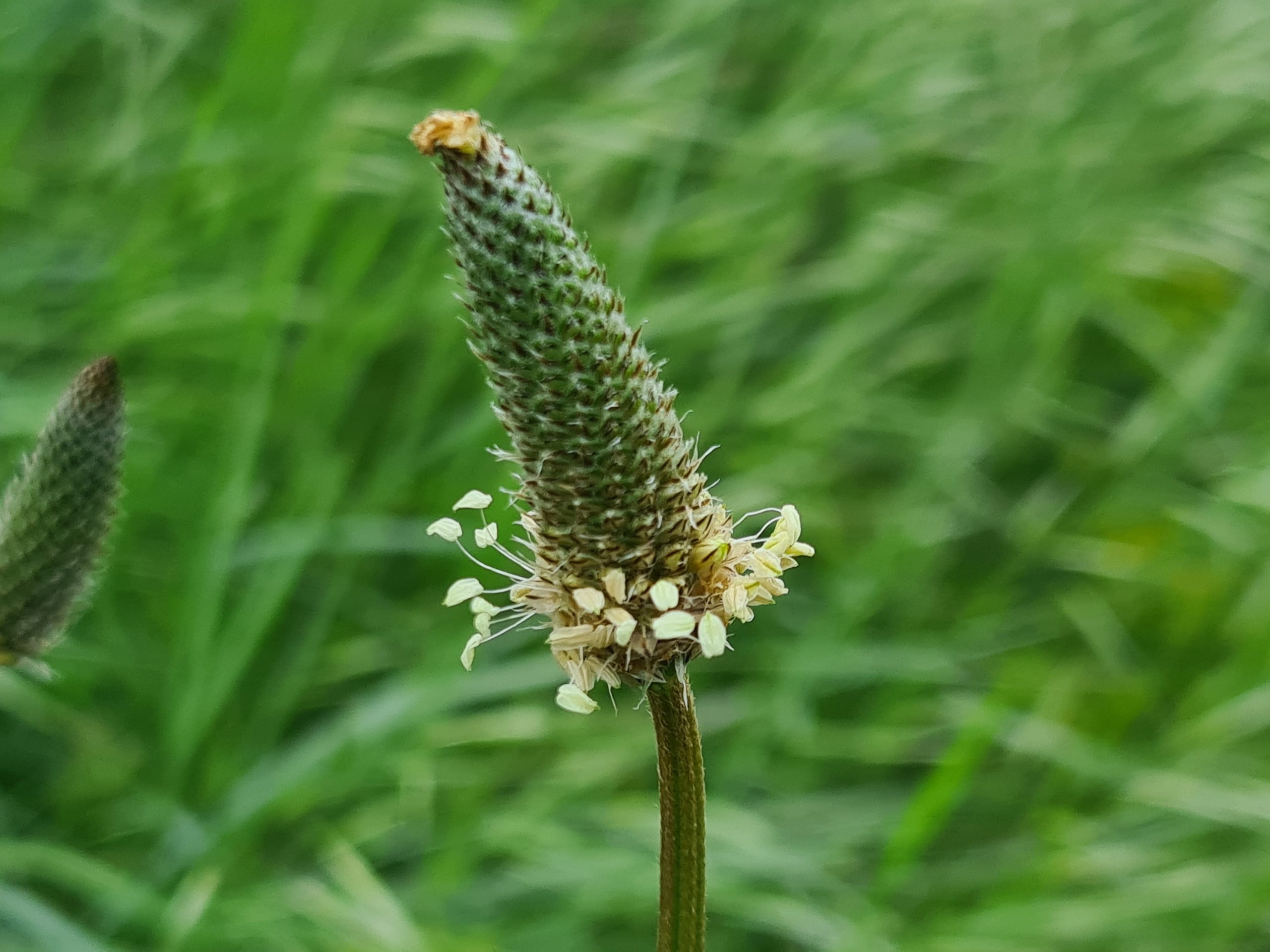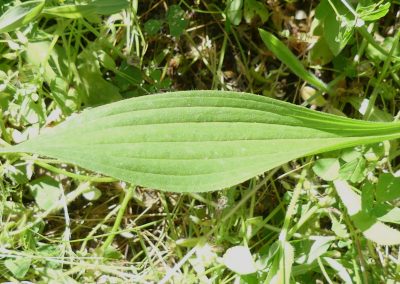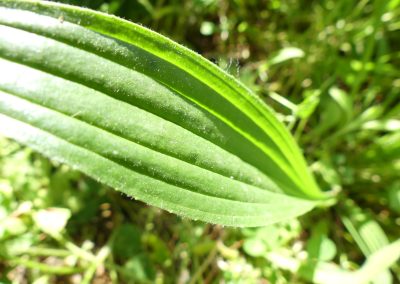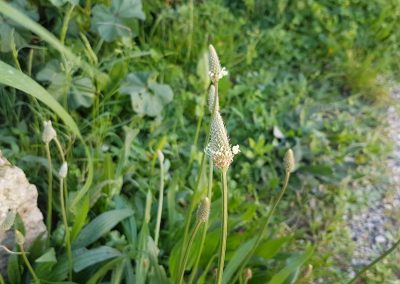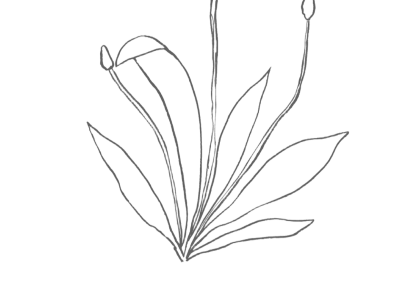Plantago lanceolata
Scientific description
Taxon: Plantago lanceolata
Class: Eudicotyledons
Subclass: Asterids
Order: Lamiales
Family: Plantaginaceae
Common name: Ribwort plantain, Narrowleaf plantain
Origin:
Europe, Western Asia, North Africa.
Description:
Perennial herbaceous plant, 10–60 cm tall. Leaves lance-shaped, mostly glabrous, with 3–7 parallel veins. Flowering stalk furrowed, pubescent, taller than leaves, with ovoid to oblong spike. Flowers bloom April–October.
Propagation:
By seeds, easy germination. Spontaneous reseeding is common.
Ecology:
Very common in meadows, roadsides, pastures. Tolerates trampling and poor soils.
Uses:
Edible leaves for salads or soups. Medicinal: anti-itch, healing, expectorant.
Threats:
No major threats. Listed as Least Concern; widespread and resilient.
Taxon: Plantago lanceolata
Classe: Eudicotylédones
Sous-classe: Astéridées
Ordre: Lamiales
Famille: Plantaginacées
Nom commun: Plantain lancéolé
Origine:
Europe, Asie occidentale, Afrique du Nord.
Description:
Plante herbacée vivace, 10–60 cm. Feuilles lancéolées, glabres ou peu velues, 3–7 nervures parallèles. Hampe florale pubescente et sillonnée, plus haute que les feuilles, épi ovoïde à oblong. Floraison avril–octobre.
Multiplication:
Par graines, germination rapide. Autoensemencement naturel fréquent.
Écologie:
Très commune dans prés, bords de chemins, pelouses, pâturages. Tolère piétinement et sols pauvres.
Utilisation:
Feuilles comestibles en salade ou soupe. Propriétés médicinales: calmant des démangeaisons, cicatrisant, antitussif.
Menaces:
Aucune menace majeure. Classé préoccupation mineure. Très répandu.
Taxon: Plantago lanceolata
Clasă: Eudicotiledonate
Subclasă: Asteridae
Ordin: Lamiales
Familie: Plantaginaceae
Nume comun: Pătlagină îngustă
Origine:
Europa, Asia Occidentală, Africa de Nord.
Descriere:
Plantă erbacee perenă, 10–60 cm. Frunze înguste, alungite, glabre sau slab pubescente, 3–7 nervuri longitudinale. Tija florală păroasă, mai înaltă decât frunzele, spic oval/alungit. Înflorește aprilie–octombrie.
Multiplicare:
Prin semințe, germinare ușoară. Autoînsămânțare frecventă.
Ecologie:
Foarte frecventă în pajiști, margini de drum, terenuri pășunate. Tolerează soluri compacte și călcate.
Utilizare:
Frunzele consumate crude sau gătite. Proprietăți medicinale: calmant pentru mâncărimi, cicatrizant, antitusiv.
Amenințări:
Nu există amenințări semnificative. Specie comună, risc scăzut.
Ταξινόμηση: Plantago lanceolata
Κλάση: Eudicotyledonae
Υποκλάση: Αστερίδες
Τάξη: Lamiales
Οικογένεια: Plantaginaceae
Κοινή ονομασία: Λανσεολάτο ψύλλιο
Προέλευση:
Ευρώπη, Δυτική Ασία, Βόρεια Αφρική.
Περιγραφή:
Πολυετές ποώδες φυτό, 10–60 εκ. Φύλλα λογχοειδή, γυμνά ή αραιά τριχωτά, 3–7 παράλληλες νευρώσεις. Ανθοφόρος βλαστός πάσχουσα, πιο ψηλή από φύλλα, με ωοειδές έως επιμήκες στάχυ. Άνθη Απρίλιο–Οκτώβριο.
Πολλαπλασιασμός:
Με σπόρους, εύκολη βλάστηση. Αυτοσπορά σε φυσικό περιβάλλον.
Οικολογία:
Πολύ κοινό σε βοσκοτόπια, άκρες δρόμων, λιβάδια. Ανθεκτικό στο πάτημα και τα φτωχά εδάφη.
Χρήση:
Φύλλα τρώγονται ωμά ή μαγειρεμένα. Ιδιότητες: καταπραϋντικό κνησμού, επουλωτικό, αποχρεμπτικό.
Απειλές:
Καμία σοβαρή απειλή. Είδος ελάχιστης ανησυχίας, πολύ κοινό.
Creative writing inspired by Plantago lanceolata
The Plantain
Once upon a time, a girl and her parents lived in a small village of around 2,000 people, in a time long before cars, telephones and everything else we know today. This girl had a peaceful life until disaster struck.
One night with full moon, giant wolves attacked the village. They're called werewolves. Every night of the full moon, they wake up and destroy everything. The wolves destroyed the whole village, which was in flames. The little girl's parents forced her to flee the village while she still could. The girl refused to abandon her parents. But a wolf had destroyed the roof of their house and was beginning to attack them. The girl's father took it upon himself to get her out of the house before it was too late. The girl, in tears, tried to struggle away. But in vain, her father ordered her to run far, far away and not look back.
After running for several kilometers without stopping, hunger and thirst overtook her when she came to a river lined with fruit trees. She went there to eat and drink, then take a nap. During her nap, she had a horrible nightmare in which she saw werewolves destroying her village over and over again. Then suddenly, she heard a voice whispering in her ear: a girl's voice saying “wake up!”
When she opened her eyes, green plantain lit up in the sun. The plantain began to talk like a human being. The girl couldn't understand how this was possible. “Nothing is impossible,” said the plantain. “There's a city where a fountain makes any of your dreams come true. Let's go!”
The two protagonists headed for the fountain. The girl vowed to rebuild her village and have the members of her village and her parents reincarnated. And her wish came true, thanks to the help of the plantain.


